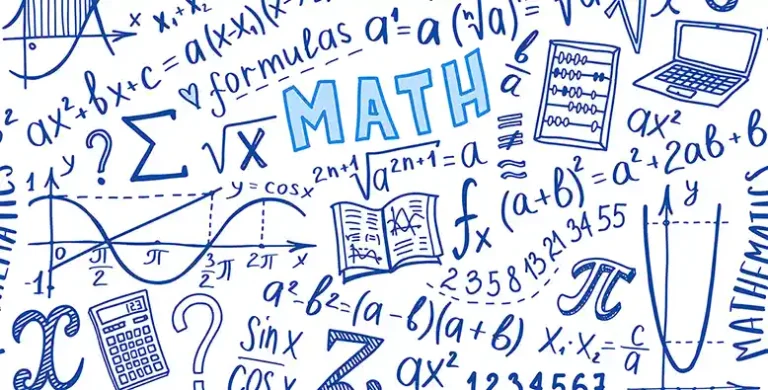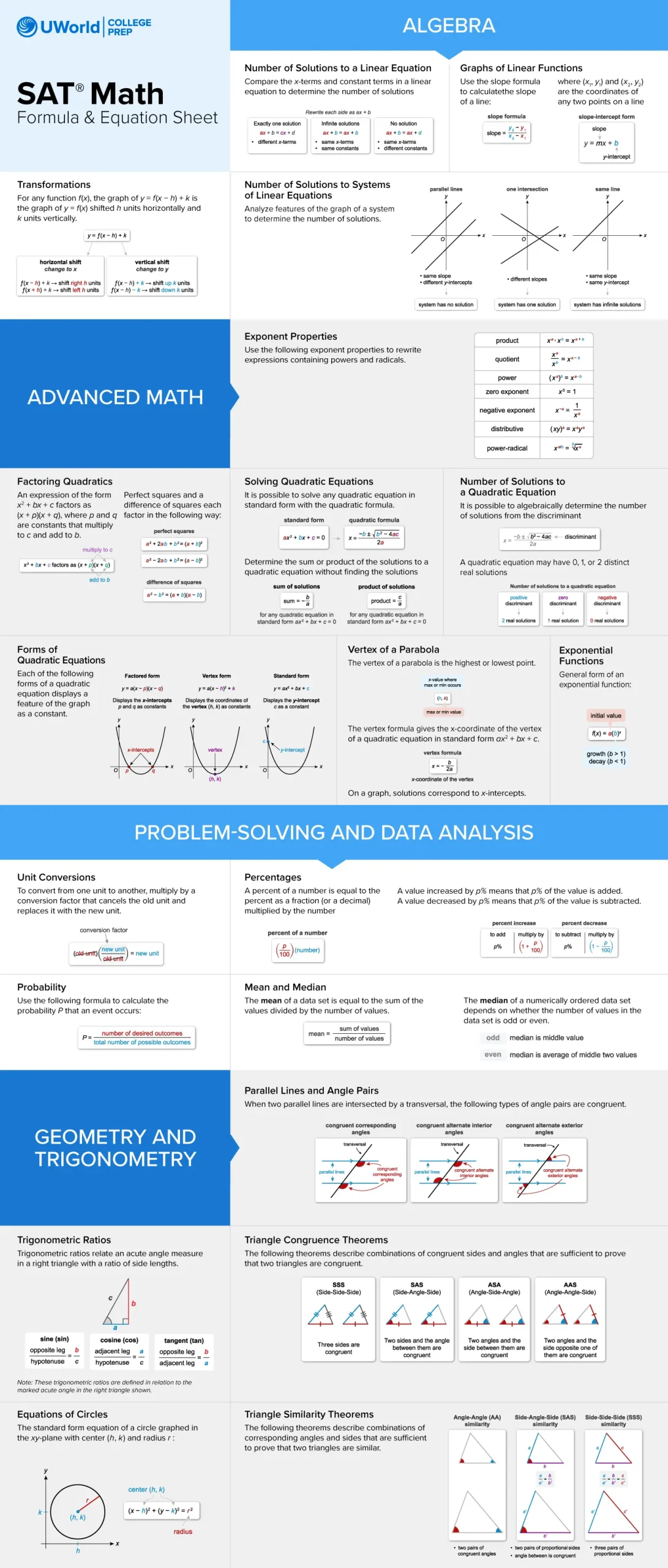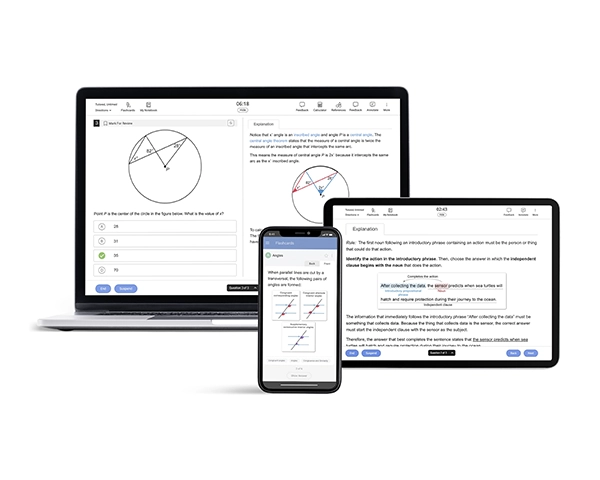The Math section counts for half of your total SAT® score, which makes strong formula mastery an important advantage. When you recognize the pattern in a question and connect it to the correct mathematical relationship, you solve more accurately and more efficiently. Practicing with SAT-level examples and reviewing illustrated explanations helps you build the reasoning skills needed to understand when, why, and how each formula is used.
What Is the SAT Math Formula Sheet?
The official SAT Math formula sheet (often called the SAT reference sheet or SAT formula sheet) appears in both modules of the digital SAT Math section. It focuses mainly on geometry and includes formulas for:
- Area of circles, triangles, and rectangles
- Circumference of a circle
- Right triangle relationships, including the Pythagorean theorem
- Volume formulas for prisms, cylinders, cones, pyramids, and spheres
- Angle relationships in triangles and circles
This sheet is helpful, but it is not complete. You will answer many questions that require formulas not included on the provided sheet. Because of this, students should review a complete list of SAT Math formulas and practice applying them in real test scenarios. To prepare effectively, use SAT-like problems that reinforce when and how to use each formula. Resources like the UWorld QBank help you practice these formulas through algebra SAT questions, geometry problems, data analysis tasks, and more.
SAT Math Formulas You Must Know (Complete List for 2026-2027)
To score well on the SAT Math section, you need a strong command of the formulas that appear on the SAT Math formula sheet as well as the many math formulas for the SAT that do not appear on the official reference sheet. The exam tests your ability to recognize patterns, select the correct formula, and apply it efficiently. Reviewing all SAT math formulas across the four content domains helps you answer questions with confidence and accuracy.
After reviewing the complete formula list below, you can continue strengthening your skills with structured resources such as the SAT course, targeted practice in the SAT question bank, and concept explanations found in the SAT study guide.
SAT Algebra Formulas
Algebra questions make up a significant portion of the exam, and students often encounter linear relationships, systems of equations, and quadratic expressions. Important formulas include:
- Slope:
- Slope-intercept form:
- Point-slope form:
- Standard form of a line:
- Quadratic formula:
- Discriminant:
- Vertex of a parabola:
- Exponential growth or decay:
These algebra formulas support many of the linear equations and systems of equations problems you will encounter on the SAT.
SAT Advanced Math Formulas
Advanced math questions rely on deeper algebraic foundations, often involving polynomials, exponents, and functions. Important formulas and concepts include:
- Function notation: f(x)
- Inverse functions
- Polynomial division concepts
- Exponential and logarithmic relationships (conceptual)
- Systems of nonlinear equations
Mastering these SAT math formulas helps you navigate more complex multi-step problems.
SAT Problem Solving and Data Analysis Formulas
These formulas help with interpreting data, solving ratio questions, and evaluating percentages.
- Ratio and proportion:
- Percent change:
- Mean, median, mode
- Basic probability:
- Average rate of change:
These are some of the most practical math equations for the SAT and appear frequently in data interpretation tasks.
SAT Geometry and Trigonometry Formulas
Most formulas in this domain appear on the official SAT Math reference sheet, but memorizing them increases speed.
- Area of a triangle:
- Area of a circle:
- Circumference of a circle:
- Pythagorean theorem:
- Special right triangles: 30 - 60 - 90 and 45 - 45 - 90 ratios
- Volume formulas: prism, cylinder, cone, pyramid, sphere
- Basic trig ratios: sin = , cos = , tan =
These are essential math formulas to know for the SAT, especially for geometry-heavy questions.
Additional High-Value SAT Math Formulas
These formulas are tested often but do not appear on the official digital SAT formula sheet.
- Distance formula:
- Midpoint formula:
- Circle equation:
- Compound interest:
- Percent increase and decrease
- Average speed and rate formulas
These important equations for SAT problem solving often appear in medium and high-difficulty questions.
Critical SAT Math Formulas Every Student Should Memorize
Even though the official SAT Math formula sheet provides several geometry formulas, many of the most frequently tested relationships do not appear on the reference sheet. To solve questions quickly and accurately, students need to have certain SAT Math formulas fully memorized. These formulas support algebra, data analysis, and advanced math questions that rely on pattern recognition and efficient problem-solving.
The following Math formulas to know for SAT success should be committed to memory:
- Quadratic formula
- Discriminant and its connection to the number of solutions
- Slope relationships and the different forms of a linear equation
- Exponential growth and decay expressions
- Distance formula and midpoint formula
- Equation of a circle
- Percent change
- Basic trigonometric ratios
- Average rate or rate of change
Students often find that these concepts show up across multiple question types. Memorizing them strengthens recall, helps avoid common errors, and reduces the time spent deciding which approach to take. When these formulas are familiar, you will recognize patterns faster and approach both easy and difficult problems with greater confidence. Regular use of practice questions is the best way to reinforce all these SAT Math formulas and understand when each one applies.
How to Use the Formula Sheet Effectively During the Digital SAT
The digital SAT formula sheet is available throughout both math modules, and knowing how to use it efficiently can save valuable time. While it includes several geometry formulas, it is not designed to provide every relationship you need. Understanding its limitations is an important part of building a strategic approach to the test.
To use the SAT reference sheet effectively, keep these principles in mind:
- Scan the sheet only when needed. If you already know a formula, rely on memory to avoid breaking focus. The reference sheet works best as a quick confirmation tool, not a primary source during every problem.
- Identify whether the question relies on a provided formula. Many problems require formulas that do not appear on the SAT Math sheet, such as the quadratic formula or percent change. Recognizing whether the necessary relationship is listed helps you decide whether to reference the sheet or use memorized knowledge.
- Understand the context behind each geometry formula. The formulas for area, volume, and angle relationships appear frequently. Knowing when to apply them makes solving shape-based questions faster and more accurate.
- Use the sheet to prevent small errors. Even when you know a formula, a quick glance can help avoid mistakes with coefficients, exponents, or variables, especially under time pressure.
- Combine formula knowledge with reasoning. The sheet cannot tell you which formula to use. You must interpret the question, identify what is being asked, and then apply the correct relationship. This is why consistent practice with realistic problems is so valuable.
Using the SAT math formula sheet in a deliberate and strategic way ensures that you spend more time solving and less time searching. With steady practice, you will quickly learn when to reference the sheet and when to trust your memorized understanding.
SAT Math Equation Sheet
You can strengthen your preparation by reviewing a complete SAT math formula sheet that organizes the most important formulas into one easy reference. The infographic below includes all SAT Math formulas you need for test day, including algebra, advanced math, problem solving and data analysis, and geometry and trigonometry. It is fully aligned with the concepts tested on the digital SAT.
This visual SAT Math cheat sheet is helpful for quick review because it groups formulas by topic and includes clear examples that show how each relationship is used. Students who prefer printable study materials can also save the infographic for offline practice as part of their study routine.
SAT Math Formula & Equation Sheet: Frequently Asked Questions (FAQs)
Do you have to memorize formulas for the SAT Math?
What formulas are given on the math portion of the SAT?
How can I quickly identify the correct formula on test day?
The best way to identify the right formula is to recognize the structure of the problem.
- A question involving lines often points to slope or linear equations.
- Quadratic behavior suggests using the discriminant or factoring.
- Shapes or distances hint at geometry formulas.
What are the hardest SAT Math formulas students forget?
Students most often forget formulas that are not on the SAT reference sheet. These include:
- Quadratic formula
- Exponential growth expressions
- Circle equation
- Percent change
- Distance and midpoint formulas
- Special right-triangle ratios


